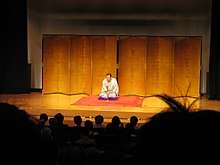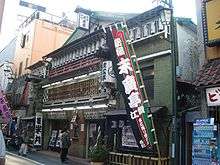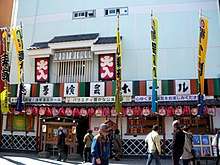Rakugo
Rakugo (落語, literally 'fallen words') is a form of Japanese verbal entertainment. The lone storyteller (落語家, rakugoka) sits on a raised platform, a kōza (高座). Using only a paper fan (扇子, sensu) and a small cloth (手拭, tenugui) as props, and without standing up from the seiza sitting position, the rakugo artist depicts a long and complicated comical (or sometimes sentimental) story. The story always involves the dialogue of two or more characters. The difference between the characters is depicted only through change in pitch, tone, and a slight turn of the head.

Lexical background
Rakugo was originally known as karukuchi (軽口).[1] The oldest appearance of the kanji which refers specifically to this type of performance dates back to 1787, but at the time the characters themselves (落とし噺) were normally read as otoshibanashi (falling discourse).
In the middle of the Meiji period (1868–1912) the expression rakugo first started being used, and it came into common usage only in the Shōwa period (1926–1989).
Description
The speaker is in the middle of the audience, and his purpose is to stimulate the general hilarity with tone and limited, yet specific body gestures. The monologue always ends with a narrative stunt (punch line) known as ochi (落ち, lit. "fall") or sage (下げ, lit. "lowering"), consisting of a sudden interruption of the wordplay flow. Twelve kinds of ochi are codified and recognized, with more complex variations having evolved through time from the more basic forms.[2]
Early rakugo has developed into various styles, including the shibaibanashi (芝居噺, theatre discourses), the ongyokubanashi (音曲噺, musical discourses), the kaidanbanashi (see kaidan (怪談噺, ghost discourses)), and ninjōbanashi (人情噺, sentimental discourses). In many of these forms the ochi, which is essential to the original rakugo, is absent.
Rakugo has been described as "a sitcom with one person playing all the parts" by Noriko Watanabe, assistant professor in the Department of Modern Languages and Comparative Literature at Baruch College.[3]
History

Rakugo was invented by Buddhist monks in the ninth and tenth centuries to make their sermons more interesting and its written tradition can be traced back to the story collection Uji Shūi Monogatari (1213–18).
Gradually the form turned from humorous narrative into monologue, probably upon the request of the daimyōs (feudal lords), seeking people skilled enough to entertain them with various kinds of storytelling.
During the Edo period (1603–1867), thanks to the emergence of the merchant class of the chōnin, the rakugo spread to the lower classes. Many groups of performers were formed, and collections of texts were finally printed. During the 17th century the actors were known as hanashika (found written as 噺家, 咄家, or 話家; "storyteller"), corresponding to the modern term, rakugoka (落語家, "person of the falling word").
Before the advent of modern rakugo there were the kobanashi (小噺): short comical vignettes ending with an ochi, popular between the 17th and the 19th century. These were enacted in small public venues, or in the streets, and printed and sold as pamphlets. The origin of kobanashi is to be found in the Kinō wa kyō no monogatari (Yesterday Stories Told Today, c. 1620), the work of an unknown author collecting approximately 230 stories describing the common class.
Important contributors

Many artists contributed to the development of rakugo. Some were simply performers, but many also composed original works.
Among the more famous rakugoka of the Tokugawa period were performers like Anrakuan Sakuden (1554–1642), the author of the Seisuishō (Laughter to Chase Away Sleep, 1628), a collection of more than 1,000 stories. In Edo (today's Tokyo) there also lived Shikano Buzaemon (1649–99) who wrote the Shikano Buzaemon kudenbanashi (Oral Instruction Discourses of Shikano Buzaemon) and the Shika no makifude (The Deer's Brush, 1686), a work containing 39 stories, eleven of which are about the kabuki milieu. Tatekawa Enba I (1743–1822) was author of the Rakugo rokugi (The Six Meanings of Rakugo).
Kyoto was the home of Tsuyu no Gorobei I (1643–1703), who is considered the father of the rakugo tradition of the Kamigata area (Kamigata rakugo (上方落語)).[4] His works are included in the Karukuchi tsuyu ga hanashi (Jocular Tsuyu's Stories, date of composition unknown), containing many word games, episodes from the lives of famous literary authors, and plays on the different dialects from the Tokyo, Osaka, and Kyoto areas.
Of a similar structure is the Karukuchi gozen otoko (One-liners: An Important Storyteller, date of publication unknown) in which are collected the stories of Yonezawa Hikohachi I, who lived in Ōsaka towards the end of the 17th century. An example from Yonezawa Hikohachi's collection:
A man faints in a bathing tub. In the great confusion following, a doctor arrives who takes his pulse and calmly gives the instructions: "Pull the plug and let the water out." Once the water has flowed completely out of the tub he says: "Fine. Now put a lid on it and carry the guy to the cemetery."
For the poor man is already dead. The joke becomes clearer when one notes that a Japanese traditional bathing tub is shaped like a coffin.
Current performers
Current rakugo artists include Tachibanaya Enzō, Katsura Bunshi VI, Tachibanaya Takezō II, Tatekawa Shinosuke and Hayashiya Shōzō (9th). Furthermore, many people regarded as more mainstream comedians originally trained as rakugoka apprentices, even adopting stage names given them by their masters. Some examples include Akashiya Sanma, Shōfukutei Tsurube II, and Shōfukutei Shōhei.[5] Another famous rakugo performer, Shijaku Katsura II, was known outside Japan for his performances of rakugo in English.
Titles
- Botan Dōrō (ja:牡丹灯籠, Botandōrō) - a kaidanbanashi
- Jugemu (ja:寿限無, Jugemu) - a ridiculously long name
- Manjuu kowai (ja:饅頭こわい, Manjuu kowai, Manjū are scary) - group of boys try to scare off a boaster[6]
- Meguro no Sanma (ja:目黒のさんま, Meguro no sanma, Pacific saury of Meguro) - naiive lord enjoyed commoner's food[7]
- Momotarō (桃太郎, Momotarō) - a meta-gag where a father is mocked by his son of his bad storytelling the Japanese folktale Momotarō[8]
- Mount Head (ja:頭山, Atamayama) - tree began growing on a man's head
- Neko no sara (ja:猫の皿, Neko no sara, The cat's plate) - man try to outwit the owner of an antique porcelain[9]
- Shibahama (ja:芝浜, Shibahama) - husband found a huge sum of money[10]
- Teresuko (ja:てれすこ, Teresuko) - cash reward to whom that could identify a strange fish
Notable rakugoka
Edo (Tokyo)
- Hayashiya Kikuō (formerly Hayashiya Kikuzō I)
- Hayashiya Konpei
- Hayashiya Sanpei I
- Hayashiya Shōzō IX
- Hayashiya Taihei
- Kairakutei Black I (Henry Black)
- Katsura Utamaru
- Katsura Yonesuke
- Kokontei Shinchō
- Kokontei Shinshō
- Reireisya Bafū
- Reireisya Suzumaru (Yamada Takao)
- Ryūtei Chiraku
- San'yūtei Enchō
- San'yūtei Enraku V
- San'yūtei Enraku VI (formerly San'yūtei Rakutarō)
- San'yūtei Kōraku
- San'yūtei Koyūza
- Sanshōtei Yumenosuke
- Shunpūtei Koasa
- Shunpūtei Ryūshō
- Shunpūtei Shōta
- Tachibanaya Enzō
- Tachibanaya Takezō
- Tatekawa Danshi
- Tatekawa Shinosuke
- Yanagiya Kosan
- Yanagiya Kosanji
Kamigata (Osaka)
- Hayashiya Somemaru IV
- Katsura Beichō
- Katsura Bunchin
- Katsura Bunshi V
- Katsura Bunshi VI (formerly Katsura Sanshi)
- Katsura Harudanji
- Katsura Shijaku II
- Katsura Sunshine
- Shōfukutei Kakushow
- Shōfukutei Matsunosuke
- Shōfukutei Nikaku
- Shōfukutei Shōkaku
- Shōfukutei Tsurube
- Showko Showfukutei
- Tsukitei Happō
- Tsukitei Hōsei (formerly Yamasaki Hōsei)
- Tsukitei Kachō
See also
- Shōwa Genroku Rakugo Shinjū
- Fallen Words
- Manzai
- Kyōgen
- Stand-up comedy
References
- "Rakugo". Big Serving. Retrieved 11 May 2007.
- Rakugo: universal laughter by Tim Ryan Retrieved 11 May 2007
- Rakugo related interview from Baruch College Retrieved 11 May 2007
- Kōjien dictionary, entries for "Tsuyu no Gorobei".
- Rakugo Performers Retrieved 11 May 2007
- Tatekawa, Shinoharu (21 August 2017). Manju kowai (Scared of Manju) (mp3). Rakugo - Japanese traditional style comedy (FM radio broadcast). Japan. Tokyo FM. Retrieved 11 November 2019.
- Tatekawa, Shinoharu (17 October 2016). Meguro no samma (mp3). Rakugo - Japanese traditional style comedy (FM radio broadcast). Japan. Tokyo FM. Retrieved 11 November 2019.
- Tatekawa, Shinoharu (5 February 2018). Momotaro (mp3). Rakugo - Japanese traditional style comedy (FM radio broadcast). Japan. Tokyo FM. Retrieved 11 November 2019.
- Tatekawa, Shinoharu (4 February 2019). Cat's Plate (mp3). Rakugo - Japanese traditional style comedy (FM radio broadcast). Japan. Tokyo FM. Retrieved 11 November 2019.
- Tatekawa, Shinoharu (18 December 2017). Shibahama (mp3). Rakugo - Japanese traditional style comedy (FM radio broadcast). Japan. Tokyo FM. Retrieved 11 November 2019.
Further reading
- Morioka, Heinz, and Miyoko Sasaki. "Universal Folktale Motifs in Rakugo Narration." In Rakugo: The Popular Narrative Art of Japan, 188-208. Cambridge (Massachusetts); London: Harvard University Asia Center, 1990. www.jstor.org/stable/j.ctt1tfjbg0.9.
- Morioka, Heinz, and Miyoko Sasaki. Rakugo: The Popular Narrative Art of Japan. Cambridge (Massachusetts); London: Harvard University Asia Center, 1990. www.jstor.org/stable/j.ctt1tfjbg0.
External links
| Wikimedia Commons has media related to Rakugo. |
- English-Rakugo web site
- YouTube Rakugo examples
- Rakugo video (in English) SFGTV San Francisco
- Bilingual Kamigata (Osaka) Rakugo web site
- Katsura Sunshine's essay concerning the difference between Kamigata(Osaka) rakugo and Edo(Tokyo) rakugo
- Learning Japanese Language and Culture through Rakugo Appreciation